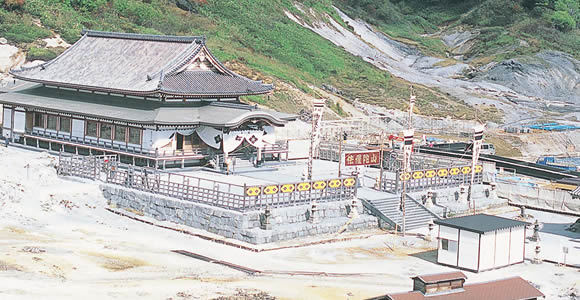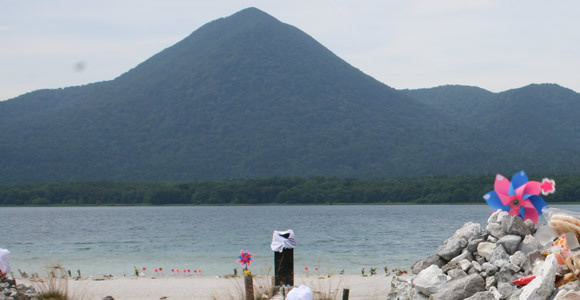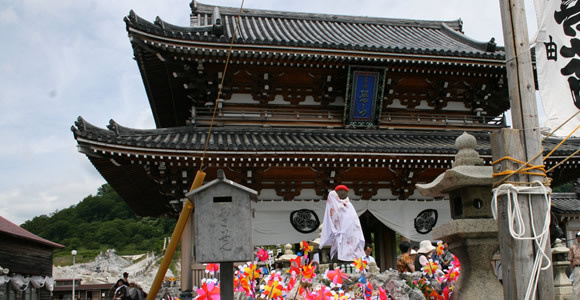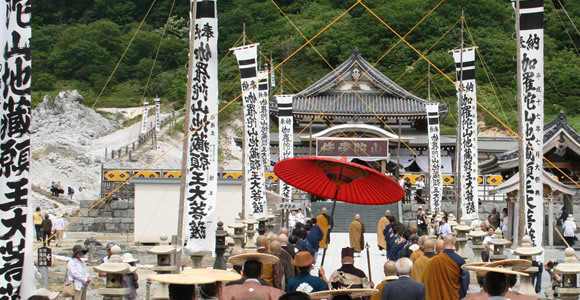| Temple names | Mt. Osore Bodai-ji Temple |
|---|---|
| Principal object of worship | Enmei Jizo Bodai |
| Founder | Jikakudaishi En-nin |
| Main temple | Entsu-ji Temple of Soto School |
| Visitor season | Every year May 1 〜 October 31 |
| Open hours | 6:00 a.m. 〜 6:00 p.m. (Hours change during the Taisai Festival and fall visiting period) |
| Taisai Festival | Every year July 20 〜24 |
|---|---|
| Fall pilgrimage | Every year during the 3-day period of which the final day is Sports and Health Day (Saturday, Sunday, Monday). |
| Admission | Adults: \500/person Elementary and junior high school students: \200/person Groups: \400/person (Only a group of 20 or more people) |
| Hours for prayer and memorial service | 6:30 a.m. /11 a.m. / 2:00 p.m. (Hours change during the Taisai Festival and fall pilgrimage period) |
| Facility information | ||
| Mt. Osore Resting House |
Open | May 1 ~ October 31 (Every day) |
| Hours | 10:00 a.m. ~ 4:00 p.m. | |
| Shukubo Kisshokaku | Shukubo Okomori (lodging charge) ¥12,000/person (one night with two meals) |
|
| For more information click here | ||
| Bus schedule (Shimokita Kotsu) |
Click here for Mt. Osore Line schedule (Shimokita Kotsu website) <Inquiries> Shimokita Kotsu Co., Mutsu Office TEL:0175-22-3221 |
|


The name "Osorezan" was "Usoriyama" during the feudal government period. In earlier times, there was a time when the Shimokita region was called "Usorikyo."
"Usori" comes from the word "ushoro" (meaning inlet or gulf) in the Ainu language, which eventually changed to "Osore" (fear).
Osorezan is a name that refers to the eight peaks of Kenzan, Jizoyama, Keitousan, Maruyama, Otsukushiyama, Kotsukushiyama, Kitaguniyama, and Byobuyama and the basin which is surrounded by them. The eight peaks are generally known to symbolize the eight-petalled lotus flower. Geologically, it refers to the series of volcanic mountains covering an area of 17 km east to west and 25 km north to south between Kamafuseyama and Asahinadake.
The basin is a caldera that measures about 4 km in diameter with Lake Usori in the center.
The emerald-green water of Lake Usori quietly reflects the beautiful green peaks of the eight mountains. But on the north shore of the lake, one can see thermal springs and hot springs gushing out from pits that lie everywhere, creating a barren landscape that some would say resembles hell.


Lake Usori is a crater lake formed within the Usori caldera. The water surface of the almost circular shaped lake is 214 m above sea level and its circumference is 12.5 km. It covers an area of 2.5 square km and the maximum water depth is about 20 m.
The water is very acidic, and only Japanese dace as well as a few other species of fish can survive.
The lake's surface, reflecting the peaks of the eight mountains that symbolize the lotus flower, is a beautifully mysterious emerald green.
On the other hand, on the north shore of the lake, there are bubbling openings of hot spring water and gas spreading the smell of sulfur in the air, which prevents almost all types of plant life. Here, the landscape is gray and barren.
The Sanzu-no-kawa, a river that flows north to east, is considered the boundary between the realms of the living and the dead, and has a vermillion arched bridge.
The river eventually becomes the Shozu River and the water flows out to the sea from the Tsugaru channel.
From the prefectural parking space, there is a path that stretches alongside the lakeshore for about 2 km. At the end of the path, there is a hiking path that circles around the lake and is about 10 km long.


It is said that in the year 862, Jikakudaishi En-nin, a high Buddhist priest of the Tendai sect during the Heian Period, was led by a cormorant to build a temple here for worshipping the Jizo bodhisattva. It is considered one of the three most sacred places in Japan.
Once you walk through the temple gate and the approach lined by more than 40 nightlights, you will find the Jizo hall where the principle object of worship is enshrined.
It is said that this is where souls of the dead gather and is the spot of the Bodai-ji Temple grounds where people try to communicate with the dead through mediums, known as Itako.
On the right side of the approach, there is the shukubo, or temple lodging, and on the left are the main temple hall and Mt. Osore hot spring bathhouses. On the temple grounds, the area toward Lake Usari is called Saino-kawara Gokuraku-hama. The area, gray and barren, is scattered with openings where hot water and steam come out of the ground.
The stacks of pebbles and stupa that lie here and there are people's offerings for calming the souls of the dead.
Every year the Mt. Osore Festival (July 20~24) and the Mt. Osore Fall Pilgrimage (October) are solemnly held.


The Mt. Osore Bodai-ji Temple grounds are inside the Usori caldera, which is why it is marked with openings that give off steam and hot water. The good thing is there are four hot spring facilities inside the temple grounds used as public baths.
The opaque hot water is acidic iron hot spring water of a hydrogen sulfide type. The Hienoyu bath is effective for treating nerve pains and rheumatism; the Kotakinoyu bath is effective for treating gastrointestinal diseases; the Hanazomenoyu bath is effective for treating skin lesions and cuts; and the Yakushinoyu bath is good for eye diseases.


The Mt. Osore Taisai Festival is held every year between July 20 and 24. Mt. Osore is believed to be the place where the souls of the dead gather, and that is why many worshippers come to pray for the souls of their ancestors and peace for the family. Dedicating the dentary bone of the recently deceased to pray for the soul's eternal peace is a custom that has lasted for generations. It is also said that praying to Jizo on the day of the festival will release lost souls from penance. The 22nd is the day of the main ceremony for climbing the mountain, the 22nd~24th is when Daihannya-kyo Sutra prayers take place, and the 20th~24th is when prayers for lost souls are held. Communication with the dead through Itako is also conducted during this period.





























